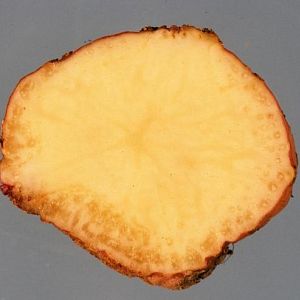Root-Knot Nematodes(Meloidogyne species)
General Description
The most important species of root-knot nematode (RKN) on potatoes are 1) northern root-knot nematodes (M. hapla) that cause small root galls and random tuber swellings; 2) southern root-knot nematodes (M. incognita) that cause large root galls and warty bumps on tubers; and 3) Columbia root-knot nematodes (M. chitwoodi) that cause pimple-like bumps on tubers.
Damage: RKNs are endoparasites that live mostly inside plants. They are important potato pests because of the galls they produce on roots and the tiny necrotic spots they cause under the tuber skin. A female nematode and her mass of eggs can be found in each spot.
Control: Treatment with soil fumigants, biofumigants, or other chemical controls is recommended when any root-knot nematodes are found in soil samples, because it doesn’t take many of them at the beginning of the season to end up with significant damage at harvest.
Registered Pesticides
| Stage of Development: Planting to Pre-emergence |
| Pesticide | MOA1 |
Efficacy2 |
Rate per Acre3 |
REI4 |
PHI5 |
Notes |
Vydate C-LV
oxamyl | 1A | G | 2.1-4.25 pt | 48 h | 7 d | Start with an in-furrow application at planting and follow with foliar applications via chemigation. The in-furrow application is optional but is recommended for risk-averse growers and when following alfalfa. |
Stage of Development: Planting to Pre-emergence
Notes: Start with an in-furrow application at planting and follow with foliar applications via chemigation. The in-furrow application is optional but is recommended for risk-averse growers and when following alfalfa.
1Mode of action. NC = not classified..
2 Efficacy ratings denote the relative ability of a pesticide to control its target. The ratings are E = excellent, G = good, F = fair/suppression; P = poor, and ND = no data. Efficacy ratings are based on the inherent toxicity of the pesticide against its target, the likelihood that the target will contact or ingest the product as applied, duration of impact on the target, and undesired effects, such as negative impacts on natural enemies that could lead to future pest outbreaks.
3 Rate per acre per application. Refer to the product label for maximum use rate per season.
4 Reentry interval.
5The minimum pre-harvest interval. Some products do not list PHI.
Note: always read and follow the directions on the pesticide label.
| Stage of Development: Emergence to Row Closure |
| Pesticide | MOA1 |
Efficacy2 |
Rate per Acre3 |
REI4 |
PHI5 |
Notes |
Vydate C-LV
oxamyl | 1A | G | 2.1 pt | 48 h | 7 d | Apply the first foliar treatment of 2.1 pints/A via chemigation at crop emergence. Follow with 2.1 pints/A when soil degree-days reach 1440 DD °F, and then 2.1 pints/A on 14-day intervals until 7 days to harvest. |
Stage of Development: Emergence to Row Closure
Notes: Apply the first foliar treatment of 2.1 pints/A via chemigation at crop emergence. Follow with 2.1 pints/A when soil degree-days reach 1440 DD °F, and then 2.1 pints/A on 14-day intervals until 7 days to harvest.
1Mode of action. NC = not classified..
2 Efficacy ratings denote the relative ability of a pesticide to control its target. The ratings are E = excellent, G = good, F = fair/suppression; P = poor, and ND = no data. Efficacy ratings are based on the inherent toxicity of the pesticide against its target, the likelihood that the target will contact or ingest the product as applied, duration of impact on the target, and undesired effects, such as negative impacts on natural enemies that could lead to future pest outbreaks.
3 Rate per acre per application. Refer to the product label for maximum use rate per season.
4 Reentry interval.
5The minimum pre-harvest interval. Some products do not list PHI.
Note: always read and follow the directions on the pesticide label.
| Stage of Development: Tuber Bulking |
| Pesticide | MOA1 |
Efficacy2 |
Rate per Acre3 |
REI4 |
PHI5 |
Notes |
Vydate C-LV
oxamyl | 1A | G | 2.1 pt | 48 h | 7 d | The first foliar treatment should have been applied at crop emergence. Follow with 2.1 pints/A when soil degree-days reach 1440 DD °F, and then 2.1 pints/A on 14-day intervals until 7 days to harvest. |
Stage of Development: Tuber Bulking
Notes: The first foliar treatment should have been applied at crop emergence. Follow with 2.1 pints/A when soil degree-days reach 1440 DD °F, and then 2.1 pints/A on 14-day intervals until 7 days to harvest.
1Mode of action. NC = not classified..
2 Efficacy ratings denote the relative ability of a pesticide to control its target. The ratings are E = excellent, G = good, F = fair/suppression; P = poor, and ND = no data. Efficacy ratings are based on the inherent toxicity of the pesticide against its target, the likelihood that the target will contact or ingest the product as applied, duration of impact on the target, and undesired effects, such as negative impacts on natural enemies that could lead to future pest outbreaks.
3 Rate per acre per application. Refer to the product label for maximum use rate per season.
4 Reentry interval.
5The minimum pre-harvest interval. Some products do not list PHI.
Note: always read and follow the directions on the pesticide label.
| Stage of Development: Late Tuber Bulking to Harvest |
| Pesticide | MOA1 |
Efficacy2 |
Rate per Acre3 |
REI4 |
PHI5 |
Notes |
Vydate C-LV
oxamyl | 1A | G | 2.1 pt | 48 h | 7 d | Foliar treatments, using 2.1 pints/A, should be applied via chemigation on 14-day intervals until 7 days to harvest. But do not exceed 19.2 pints/A total for the season. |
Stage of Development: Late Tuber Bulking to Harvest
Notes: Foliar treatments, using 2.1 pints/A, should be applied via chemigation on 14-day intervals until 7 days to harvest. But do not exceed 19.2 pints/A total for the season.
1Mode of action. NC = not classified..
2 Efficacy ratings denote the relative ability of a pesticide to control its target. The ratings are E = excellent, G = good, F = fair/suppression; P = poor, and ND = no data. Efficacy ratings are based on the inherent toxicity of the pesticide against its target, the likelihood that the target will contact or ingest the product as applied, duration of impact on the target, and undesired effects, such as negative impacts on natural enemies that could lead to future pest outbreaks.
3 Rate per acre per application. Refer to the product label for maximum use rate per season.
4 Reentry interval.
5The minimum pre-harvest interval. Some products do not list PHI.
Note: always read and follow the directions on the pesticide label.
| Stage of Development: Fall Field Preparation |
| Pesticide | MOA1 |
Efficacy2 |
Rate per Acre3 |
REI4 |
PHI5 |
Notes |
Telone II
dichloropropene | 11 | E-G | 15-25 gal | 5 d | | Columbia root knot nematodes: use 20 gal/A for mineral soil or 25 gal/A for muck. Northern root knot nematodes: use 15 gal/A for mineral soil or 18 gal/A for muck. Shank-in at 18-inch depth or more. Soil temperature must be between 40°F and 80°F. |
Stage of Development: Fall Field Preparation
Notes: Columbia root knot nematodes: use 20 gal/A for mineral soil or 25 gal/A for muck. Northern root knot nematodes: use 15 gal/A for mineral soil or 18 gal/A for muck. Shank-in at 18-inch depth or more. Soil temperature must be between 40°F and 80°F.
Notes: Columbia root knot nematodes: use 20 gal/A for mineral soil or 25 gal/A for muck. Northern root knot nematodes: use 15 gal/A for mineral soil or 18 gal/A for muck. Shank-in at 18-inch depth or more. Soil temperature must be between 40°F and 80°F.
1Mode of action. NC = not classified..
2 Efficacy ratings denote the relative ability of a pesticide to control its target. The ratings are E = excellent, G = good, F = fair/suppression; P = poor, and ND = no data. Efficacy ratings are based on the inherent toxicity of the pesticide against its target, the likelihood that the target will contact or ingest the product as applied, duration of impact on the target, and undesired effects, such as negative impacts on natural enemies that could lead to future pest outbreaks.
3 Rate per acre per application. Refer to the product label for maximum use rate per season.
4 Reentry interval.
5The minimum pre-harvest interval. Some products do not list PHI.
Note: always read and follow the directions on the pesticide label.
| Stage of Development: Preplant |
| Pesticide | MOA1 |
Efficacy2 |
Rate per Acre3 |
REI4 |
PHI5 |
Notes |
Telone II
dichloropropene | 11 | E-G | 15-25 gal | 5 d | | Columbia root knot nematodes: use 20 gal/A for mineral soil or 25 gal/A for muck. Northern root knot nematodes: use 15 gal/A for mineral soil or 18 gal/A for muck. Shank-in at 18-inch depth or more. Soil temperature must be between 40°F and 80°F. |
Stage of Development: Preplant
Notes: Columbia root knot nematodes: use 20 gal/A for mineral soil or 25 gal/A for muck. Northern root knot nematodes: use 15 gal/A for mineral soil or 18 gal/A for muck. Shank-in at 18-inch depth or more. Soil temperature must be between 40°F and 80°F.
Notes: Columbia root knot nematodes: use 20 gal/A for mineral soil or 25 gal/A for muck. Northern root knot nematodes: use 15 gal/A for mineral soil or 18 gal/A for muck. Shank-in at 18-inch depth or more. Soil temperature must be between 40°F and 80°F.
1Mode of action. NC = not classified..
2 Efficacy ratings denote the relative ability of a pesticide to control its target. The ratings are E = excellent, G = good, F = fair/suppression; P = poor, and ND = no data. Efficacy ratings are based on the inherent toxicity of the pesticide against its target, the likelihood that the target will contact or ingest the product as applied, duration of impact on the target, and undesired effects, such as negative impacts on natural enemies that could lead to future pest outbreaks.
3 Rate per acre per application. Refer to the product label for maximum use rate per season.
4 Reentry interval.
5The minimum pre-harvest interval. Some products do not list PHI.
Note: always read and follow the directions on the pesticide label.



